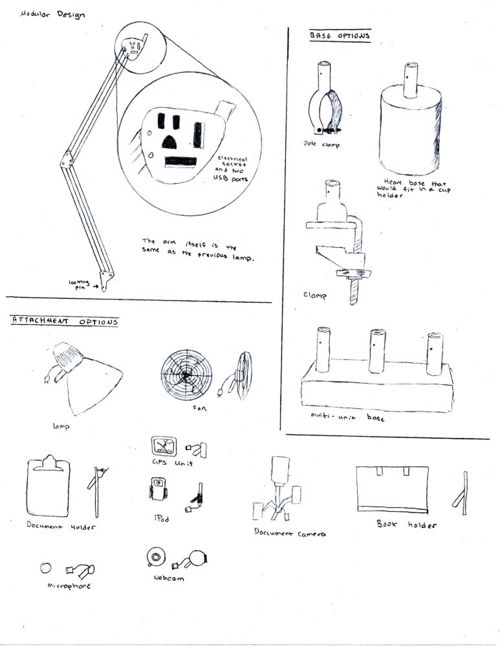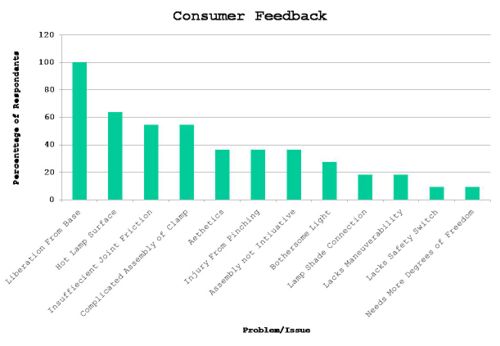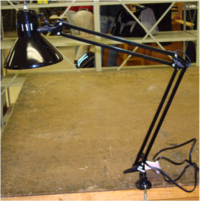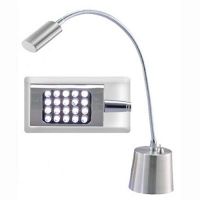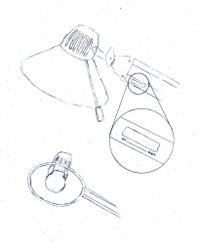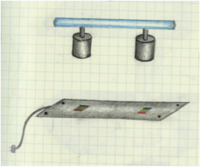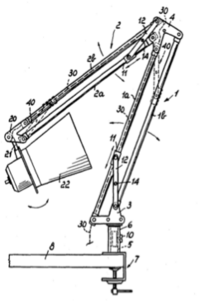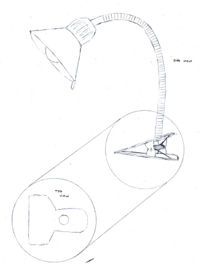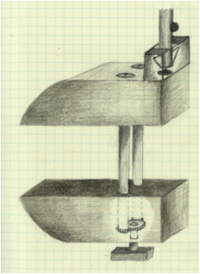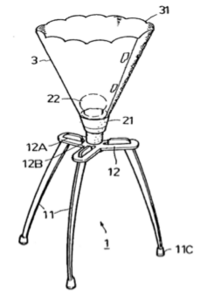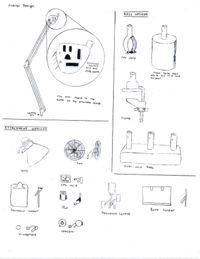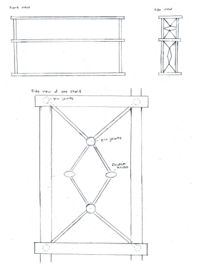Lamp stand mechanical arm redesign
From DDL Wiki
Executive Summary
Our group developed a new "modular desk assistant" design that was inspired by the mechanical lamp arm that we studied. Our main design objective was to fix the glaring flat that the lamp in it's current design lifts out of the base when handled in normal usage. Other, subsidiary objectives were making the complicated base clamp easier to assemble, and finding ways to make the lamp adjustable without the hot shade burning the user.
The existing desk lamp that was analyzed held an intended market of students and corporations, mainly due to the inexpensive price of the lamp. Because of this, we chose to conduct our user research by observing university students and professionals as they interacted with said lamp. Most users were significantly unhappy with the current lamp, citing various reasons that we took into consideration with our design objectives. Alongside our user studies, we looked at current state of the art designs that are already on the market, and we researched patents that have been granted which pertain to our lamp.
In looking at our research: user interviews, state of the art lamp designs, and past patents, we were able to find three areas in which to move forward. The first route was to focus on the task of lighting. These solutions would find ways to respond to customer complaints about the lighting process, or come up with new ways in which to provide lighting. The second route was to improve the mechanical design of the lamp. These solutions would focus on the problems we had found in the mechanical components, in particular the base. The third route was to use the lamp as a springboard to find a new market area for innovative designs.
After brainstorming over 100 ideas, our group narrowed our ideas down to the following:
- Ceramic Light Shade
- Magnetic Base
- Gooseneck
- Gear Based Lamp
- Modular Desk Assistant
- Dynamic Shelving
Although the other designs were clear improvements over the existing lamp, the same needs have already been met in state of the art designs. The Modular Desk Assistant is a more promising investment since it is expanding the market in an entirely new direction. We could not find another product on the market that does what our Modular Desk Assistant is designed to do: that is, to provide easy access to multiple objects such as a lamp, fan, or web-cam. These interchangeable attachments could be used at the users pleasure, as each was needed. The Modular Desk Assistant can be cheaply produced: a base model could be sold for $20. Countless affordable attachments can follow, along with packages geared towards specific markets such as students or engineers. These, along with adapters to work with existing products will allow users to attach practically any product to the Modular Desk Assistant . We believe that the Modular Desk Assistant will be widely received as it fill an empty niche in the current market.
Design Objectives
The main design problem with this desk lamp is stability while maneuvering the lamp to the desired position. According to research (explained in detail below), the main issue with this desk lamp is stability during use. The lamp either liberates itself from the base during use or it does not stay in the desired location. Both of these issues account for roughly a 31% of the complaints with the lamp. The need to address the issue of stability while maneuvering is, therefore, the primary design problem.
The secondary design problems with the desk lamp would be the high temperature of the lamp shade during use and the difficult assembly of the clamp when attaching the base to the surface. These together account 25% of the complaints with the lamp (There were more consumers concerned with the temperature of the surface rather than the clamp attachment issue).
Results of Research
The graph to the right shows the feedback resulting from our ethnographic study These people are all part of the focus market segment of students, universities and offices.
The percentages above to not equal to 100 because this graph counts one feedback comment as one entry. Thus it does not express the numbers of respondents, rather the percentage of respondents that had that response as feedback among their list of complaints.
We will only focus on the first 4 feedback results from the customer since they were the most prevalent concerned expressed by the customer. These concerns are summarized below.
- 100% of the participants agreed unanimously that the liberation of the base during maneuvering is an problem with this lamp
- 62% of the participants also expressed concern about the high temperature of the lamp shade, causing a safety hazard while in use.
- 52% of the consumers agreed that the lack of friction in the joints is also a concern when maneuvering the lamp. The need to tighten the friction knobs just right also caused a lack of sufficient friction because the users did not intuitively know when sufficient friction was reached.
- 52% of the participants had difficulty assembling the clamp that secures the base to the surface. This was mainly due to the complex “look” of the base with its multiple holes
The other responses occurred in less than half the complaints about the product. Some of these issues will be addressed indirectly through the other design improvement, but these are not the focus of our efforts.
Stakeholders
Below is a list of the stakeholder needs in different phases of the products life.
- Manufacturing
- Meeting tolerances set by designer
- Decrease variation when manufacturing part
- Safety of the shop floor is maximized, while keeping costs as low as possible and completing parts in a reasonable time frame
- Should choose the machinery to manufacture part since they have the most experience with the manufacturing process
- Matching the capability of the machinery to the requirements for the part to avoid excess cost
- Minimize the number of steps in the manufacturing process and creating easy transitions from one manufacturing process to the next
- Assembly and Packaging
- Efficient assembly procedure in place
- Clear instructions on how to assemble
- Minimal variety of tooling used
- Since tooling is cheap, have a supply of back up tooling
- Ensure correct tool is used for the task at hand. For example ensure the screwdriver can fit perfectly into the screw’s head
- Create a testing scheme to ensure the quality of the product released to the public.
- minimize the volume the product takes up to decrease size of container
- Minimize weight to decrease shipping cost
- Provide labels on package such that consumer can quickly identify if the product can meet the need of the consumer
- Retail
- Small packaging to allow for less space taken up on the shelf
- Light weight for easy movement
- No fork lift required for movement of product in bulk
- Low bulk purchase cost
- Reliable to ensure minimal product returns or exchanges
- Consumer
- Low cost option relative to utility obtained from product
- Precise placement of light source can be obtained throughout the life of the lamp.
- Stable fixture for light source
- Eliminate the need to touch hot surfaces while lamp is in use
- No assembly required. If it is required no tooling or instructions required
- Movement of light source can be obtained with minimal force needed.
- Aesthetically appealing
- No injury incurred while using lamp
- Maximum brightness of light source to illuminate large area
- Light source (bulb or LED) should not be visible to the user during normal use
- Easy and reliable on/off mechanism
- Long cord, but short enough so it does not cause too much apparent clutter.
- Light weight and easy to transport
- Packaging with sufficient information to ensure product can meet needs of customer
Description of Solutions
Ceramic Lamp Shade
The arm of the as well as the clamp have been left the same as the lamp brought to us by Initech. This design focuses more on addressing the temperature complaints of the consumer. This was done by attaching a ceramic lamp shade to the base of the lamp head. A handle has also been attached to the lamp shade to allow users to manuever the lamp without having to touch the lamp shade if they are very sensitive to heat. The third improvement was a touch sensitive dimmer attached on one of the arms of the lamp. This would remove the need from the user to reach behind the lamp(the area with maximized heat transfer due to slots) to shut off the lamp. The dimmer also allows the user to control how hot the lamp gets.
Features
- Ceramic lamp shade keeps the temperature of the lamp shade lower to be easier to handle during operation
- Handle would remove the very heat sensitive users from having to touch the moderately hot ceramic
- Dimming feature allows the user to control the temperature of the lamp
- Dimming switch's position eliminates he need for heat sensitive users from having to reach near rear to turn off lamp
Areas for Improvement
- Manufacturing the ceramic metal interface could be tricky
- Increased cost due to dimming feature
Market Analysis
This lamp would appeal most to the same demographic that bought the original lamp, that is:
- Students
- Corporations
- Universities
These groups would find the ceramic lamp shade, which is cooler to the touch then the metal shade, very appealing. At the same time, the lamp would still be within their price range. Other demographics, such as office workers and households, might be more willing to buy a more expensive lamp.
Magnetic Base
The Magnetic Base with Current solution has a metal base that can be screwed to almost anything and has an LED light that magnetically attaches to the base. The light could come with multiple bases so that the consumer could have a base screwed to a desk, a wall, or a bed headboard. The electric circuit is completed when the magnetic posts attach to the base. The magnetic posts have a wire that goes through the center to the light. Four electrical strips on the base and the posts make it so the circuit will only be completed when they line up correctly. This makes the lamp very safe, keeping the user from a possible electrical shock.
Features
- The LED light is long-lasting and doesn't get hot
- With multiple bases, on light can be moved to many locations in a room
- It is very easy to use since the magnet does the work of connecting the base to the light
Areas for Improvement
- Creating a circuit to go through the base and be completed by the touch of the light posts could be difficult to make
- The magnets would have to be very strong and could attract other metal objects
- This could be expensive to make due to the LED light and the special electric circuit
- Possibility to pinch user when connecting the two magnets
Market Analysis
This design has an expanded demographic from the previous one.
- Office workers
- Household
- Universities
- Corporations
Office workers and households would be willing to buy this light for it's mobility, and the ability to attach it to any location a magnetic bas has priorly been attached. This design may not be ideal for the college student and university market because the production costs may be too high.
Gooseneck Lamp
The Goose Neck Lamp solution has a lamp on the end of Goose Neck. The method chosen to attach this design to the bases was a simple clamp. This solution addresses various concerns of the customer. Given the right surface to connect to, the Goose Neck is very stable while being maneuvered into position. The clamp now requires virtually no assembly, addressing the complexity in the prior clamp. The high temperatures seen in the current design would be indirectly addressed by attaching a handle to the shade that allows the user to move the lamp without touching the lamp. A foil inner liner for the lamp shade also helps to reflect radiation and keep the lamp shade as cool as possible directly addressing the customer concern with the high temperatures seen in the research.
Features
- Directs heat away from lamp shade keep it as cool as possible
- Handle allows for repositioning without needing to touch the lamp shade
Areas for Improvement
- Limited range of locations it can safely be attached to
- Ceramic to metal attachment will be difficult to accomplish
- Clip may have a tendency to fall apart
Market Analysis
This lamp would appeal most to the same demographic that bought the original lamp, that is:
- Students
- Corporations
- Universities
As well as:
- Elderly
- Disabled
These groups would find the gooseneck arm an improvement over the arm made of rods since it would be less likely to pinch fingers. Also, the clip base is easier to use and more intuitive, especially if one wants to reach behind a desk and attach it with one hand. At the same time, the lamp would still be within their price range. Other demographics, such as office workers and households, would be more willing to buy a more expensive lamp.
Gear Base
The Gear Base lamp has a very similar body design to the standard lamp we dissected, but has a much more user-friendly base. The clamp doesn't require much force to tighten due to the gear ratio of the large center gear to the small outer gears. The two small outer gears are connected to screws that adjust the clamp. Having two screws instead of one provides a more stable hold on the surface being clamped. The umbrella-style snap-in post for the lamp arm keeps the lamp arm securely connected to the base. The post at the bottom of the arm snaps into the base and a push of a button releases it. The arm has only one bar instead of two. The joints and lamp head are otherwise very similar to the standard lamp.
Features
- Provides a stable connection to surfaces
- Easy to tighten base clamp
Areas for Improvement
- Doesn't have improved joints
- The lamp hood could possible burn the user
- The umbrella-style snap-in post may be difficult to construct
Market Analysis
This lamp would appeal most to the same demographic that bought the original lamp, that is:
- Students
- Corporations
- Universities
As well as:
- Elderly
- Disabled
In particular, this lamp is ideal for the elderly and people who are constantly readjusting the lamp's position. The elderly won't have a problem making the base tight enough to stay on a surface. The snap-in post keeps the arm from disconnecting from the base when the lamp is grabbed and repositioned.
Modular Desk Assistant
This design concept features modular attachments on both upper and lower termini at the ends of the arm. On the upper termini there are 2 USB ports and one electrical outlet. allowing for a variety of attachment options, each serving a different niche group. These attachments include options like those listed below:
- Fan-appealing to general users that need a personal cooling fan
- Document holder- anyone that would need to view while performing a task such as cooks, engineers, secretaries, and students
- Webcam & Microphone-This would appeal to the people who use webcams often to communicate with friends, family or co-workers that are not conveniently close.
- USB powered LED lamp- allows for illumination while traveling or when not near a power outlet
- Document Camera-Professors & business men would be intrigued by this because they could have a travel lamp one moment then switch to a document camera to collaborate with teams
The base is dealt with in a similar manner. It has modular attachments that serve different purposes depending on the users need. The issue of the arm liberating from the base is addressed by using a locking pin. The clamp also has a wider footprint on the table allowing for increased stability when maneuvering the product. The difficulty of the consumer assembly of the clamp is also taken care of because the clamp in this design eliminates unnecessary holes. This would serve to increase the intuitiveness of the assembly procedure for the consumer.
Features
- Reaches many markets because of many functions
- Small problems with previous mechanical parts are solved (Locking pin in base prevents the pieces from liberating on their own)
- Large number of possible attachments allow for further innovation and marketing
Areas for Improvement
- Many parts make compact packaging more difficult & limits number of standard attachment options
- Heavy base is cumbersome
- Storage needed for bases and attachments that are not currently being used
- Joints are not improved so long term life is not extended, leading to decreased ability.
- Issues with temperature of lamp surface not addressed
Market Analysis
This design has, by far, the largest demographic. Among the possible users are:
- Universities
- Students
- Corporations
- Household
- Office workers
- Small businesses
- Transportation industry
This design appeals to anyone who needs access to changing objects in their space. Students may want a lamp while studying in the evening, and later a fan during the day. Businessmen who travel may want a portable lamp on an airplane, and a document reader in their hotel rooms. People with loved ones overseas will appreciate the option of a webcam and microphone. Packages geared towards specific markets such as students or engineers would be a good way to target specific markets. These could include combinations such as Ipod/lamp/fan attachment for students.
Dynamic Shelving
The Dynamic Shelving option isn't a lamp, but is ideal for the target markets. The shelves are adjustable in height in relation to each other. Rack and pinion gears allow the cross supports to move horizontally while the shelves move vertically. The top shelf is mounted to the wall and has to hold the weight of all the shelves and their loads.
Features
- Adjustable heights
- Easy to manufacture due to few parts made multiple times
Areas for Improvement
- The top shelve has to support the weight of all shelves and their loads
- Contents of shelves need to be removed in order to adjust height
Market Analysis
The Dynamic Shelving appeals to multiple user groups including:
- Students
- Businesses
These shelves are ideal for offices or dorm rooms. Our target markets (college students and universities) would be very interested in them because of their changeable heights. Outside of our target market stores that sell various sizes of goods would be interested in this product. Especially for the sale rakes in the front of the store. The ease of changing the height of the shelf might appeal to them. This would not, however, be a good product for stores use on all their shelves because the current shelf option is probably cheaper and has less parts.
Pugh Charts
We chose to make three pugh charts because there were three different attributes we were looking for in a lamp. First, we wanted to compare lamps that provide good light. Second, we wanted to compare lamps that had a flexible arm. Finally, we also wanted to come up with some new designs that didn't focus on lighting or flexibility. Safety was weighted the highest in all three pugh charts because we thought that lamps can cause burns and pinches if safety isn't taken into account. Being affordable is important because our target markets are universities and college students, so being affordable was weighted by 2. The other three weights change with each chart.
Lighting
The weight is higher for the good lighting parameter because this specific pugh chart focuses on design ideas pertaining to lighting. Design 1 stays with the same idea as the Standard Light, but is more flexible, safer, and has better lighting. Design 2 goes in a different lighting direction than the Standard Light and has much better lighting. Both designs are better than the Standard Design and have very close scores.
The similar light patent,State of the Art LED light, received the ratings it did because it solves all of our design deliverables in the following ways:
- The LED light decreases the temperature of the lamp surface, making it safer to use while providing good lighting
- It has a simple on/off switch which make it easy to use
- Gooseneck feature makes lamp very flexible
It however lost points on affordability because it costs $60.
Mechanical
The weight is higher for the flexible parameter because this specific pugh chart focuses on design ideas pertaining to the mechanical aspect of the lamp. Design 1 uses a different arm than the Standard Light. The gooseneck allows the lamp to move and stay in almost any direction. Design 2 focuses on improving the base of the Standard Light. Both designs are much better options than the Standard Design.
The Similar Mechanical Patent received the ratings it did because it is very similar to the Standard Lamp, which we dissected. Its notable attributes are the following:
- The lamp has the double bars in the arm, which are unsafe
- It is very flexible
- It does not have a large enough lamp hood to provide good lighting
New Designs
The weight is higher for the easy to use parameter because this specific pugh chart focuses on design ideas that are completely new and focus on the consumer's needs. Design 1 uses interchangeable bases and payloads, which creates more functions for the arm and gives the consumer many options. Design 2 goes in a completely different direction than a lamp and focuses on the target markets' needs. Since the target markets are college students and universities, adjustable shelves are a great addition to any dorm room or office. However, Design 2 doesn't score high in safety or lighting, which gives it a low score in comparison to the Standard Light and Design 1.
The Similar New Design Patent received the ratings it did because although it is a simple lamp, it doesn't have the arm we are looking for. Its notable attributes are the following:
- It has a large hood, which provides a lot of light
- It is very simple and easy to use because it does not have a difficult assembly
- It is not flexible at all
Recommendations
We recommend that Initech implement the modular desk assistant as the solution to the Design issues. The modular desk assistant addresses all the design Critical-to-quality issues as described below:
- The modular desk assistant addresses the issue with the liberation of the arm from the base by including a pin that ensures the arm will not be liberated from the base while maintain full the 360 degree rotational ability of the arm.
- The modular assistant also includes an improved clamp base that helps to maintain stability by widening the footprint of the clamp on the surface.
- It also tackles the issue of the complex clamp assembly by reducing the amount of confusing holes in the base.
- Research also indicated that the high temperatures seen on the surface of the lamp near the bulb was also an issue. The proposed solution also could incorporate the LED lighting source feature from the magnetic desk lamp solution; lowering the temperature of the lamp shade.
These four features of the modular desk assistant would alone solve Initech's problems with its current lamp. But we believe Initech easily can go further to obtain more market share. The modularity of this design would allow consumer to combine the functions of many different desk accessories into one simple and easy to use option that addresses their needs. Market research shows that 80% of the target market would purchase the modular desk assistant. This shows that Initech can appeal to this undeserved market.
According to our Pugh chart this innovation scored a 6. This, however, can be misleading because it is not scored on the aspects of that modular desk assistant that will redefine the users experience with lamps and desk accessories. Therefore, in spite of the moderate score on the Pugh chart, this design innovation is the best concept for Initech.
Patents & Competitive Analysis
Existing Patents
We are currently calling our new design a modular desk assistant. Because of this, we searched for items on www.google.com/patents including terms such as Modular Arm, Desk Lamp, Modular Assistant, Modular Lamp, and Modular Arm. In all of this searching, we found few similar overall designs, but many of the designs resembled our idea in some way.
The following patents are existing patents that are the closest to our current design that could be found:
- 4259876 - Mechanical Arm
- 3543019 - Equipoised Lamp
- 4455008 - Modular Support System
- 5101332 - Retractable Device for Desk Lamp
Some of the patents will be compared in the Pugh charts elsewhere in this document, using our purchased model as a baseline in order to get an all around comparison of our modular lamp configuration to other similar designs.
Most Competitive Existing Patents
The closest competitor to the Modular Desk Assistant is the Support Apparatus and Modular Support System above. It resembles our design in the fact that it holds a book for the user and attaches to an arm chair. Outside of that, it appears that our design is completely unique with little to no competition, aside from its non-modular equivalents. This lack of competition will likely let us appeal to hybrid markets, such as a user who desires both a lamp and a fan (such as a college student) but prefers the lamp to work at night when it is cooler, and the fan during the day when it is warm. The result is a single product that fulfills all the user's needs at once instead of them buying two independent products. For this reason, we are competing with any other product that delivers the same function as one of out modules, however we offer it more efficiently and likely cheaper.
Gant Chart
Team Member Roles
Adam Aaron
- Patent study & summary
- Competitive analysis
- Lead Brainstorming sessions
- Edit Presentation
Gwendolyn Barr
- Drawings of design solutions with Ella
- Write executive summary
- Conduct user research studies
- research affected markets
Raysel Martinez
- Team Leader
- Conduct user research studies
- Write product descriptions
- Write summary of research
- Revamp stakeholder needs
- Justification for product choice
- Create presentation
Ella Swearingen
- Construct Gant charts & Pugh charts and their descriptions;
- Write product descriptions
- Drawings of design solutions with Gwendolyn
Appendix
Brainstorming Ideas
- Light source of LED or CFL
- Switch break/ hard to turn
- Clapper to turn on lamp
- IR coating to project heat out of lamp
- Lamp shade of thermally insulating material
- Ceramic lamp shade (space shuttle ceramics)
- Insertable plates of shapes for children/protection
- Fan to cool lamp
- Touchpad switch
- Multiple states of brightness
- Timer for on off
- Change plate cover opacity
- More recyclable materials
- Lever on switch
- Use plastics for lamp
- Don’t use lamp but have eyewear that had light source
- Backlit paper
- Wall light
- Track on desk to move light source
- Light with monitor clip
- LED desk lamp via USB
- Cord w/ adapter for auto
- Fairy Dust
- Candles
- Heat from candles used to power lamp using thermal electric generating cells
- Crank powered lamp
- Rechargeable battery powered lamp
- Hamster powered lamp
- Coat inside of hood with thermal cells
- Charge/focus light intensity
- Impact protection turns off itself when falling
- Magnetic link (like with macbooks)
- Design better joints
- Improve base multiple types
- 3 state motor to lock tight joint
- Gooseneck
- Rubber material better attachment
- Extend base of arm
- Magnetic base
- Foldable / collapsible arm
- Plastic on arm must detach better
- Joints that use same plates
- Only needs 1 screw type
- One bar vs. 2
- More DOF near the center
- Spring joints
- Gauge torque / ratchet (reduces guess work whether bar will stay up
- Ergonomic handles
- No pinch arms
- Animal shapes in arms (appeals to children). Adult theme in same package
- Heat sensitive paint
- “hot” notice on top
- 1 part base (minimal assembly)
- Retractable arms
- Backwards joints (like dogs legs)
- Eliminate confusing base holes
- Suction cups or base
- Changeable bottom base to max friction b/t bases
- “post-it” adhesive
- Padded (child-safe)
- Motorized press a button and moves to pre-programmed setting
- Rechargeable lamp head
- Fan
- Document holder
- Document arm/ lights
- Photo collage/board
- Office supply holder
- GPS enabled (for hiking)
- Tool holder
- Webcam holder
- Microphone holder
- Ipod holder
- Dynamic shelf space
- Reaching assistant for objects
- Any USB device
- Kitchen lift for elderly
- Industrial lift
- Extra leverage on garden tools
- Extra reach on garden tools
- Lattice structure for positioning
- Mooring for a dog’s leash
- Base that can hold multiple lamps
- Mass at bottom that fits in cup holder
- Beverage holder
- Beverage dispenser
- Attachable to back pack
- Integrated nutcracker
- Light-up pen
- Desk w/built in light
- Ball joint for base
- No switch- turn on/off by plugging in and unplugging
- Voice activated
- Motion activated
- Super-heavy base
- Velcro
- Hitch base
- Desk w/built-in base
- Rubber frame
- Lighthouse shaped
- Waterproof
- Air freshener light
- Secure lamp-base connection
- Lamp hood handle
- Attachable to computer screen
- Crank base
